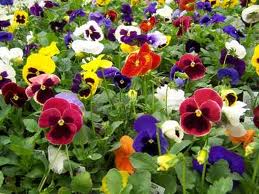If you’re looking for something to plant in the fall to brighten up your winter garden, consider planting pansy flowers. This is a flower that can take a light frost and keep right on blooming.
Pansies have been known to poke through the snow in the northern parts of the country. As such, they will have no problem growing over the winter in the regions of the country where it doesn’t freeze real hard through the winter. Unfortunately, they don’t take the heat as well as the cold, so don’t expect them to keep on going into the summer where it is hot and dry.
Pansies are a hybrid of the viola species, true violas being a little smaller in stature. They can be planted in the fall from plugs that come in cell packs of four or six plants. The fancy petals of pansies smile at us (literally) in beautiful shades of purple, gold, and pink. Pansies grow to about 8 inches tall and are typically planted in beds and borders. For the best impact, plant in a nice cluster of complimentary colors.
The petals of pansies are edible and make for splendid garnishes on salads and desserts. Candied violets can be made by brushing the flowers with whipped egg white, then sprinkling with a fine sugar. Allow to dry overnight. Now how’s that for a culinary treat!
To keep your pansies flowering profusely, pick the spent blossoms regularly (also known as deadheading). This practice will cause the plants to branch out more, thus producing more flowers.
How to Plant Pansies
Seeing is believing!
When to plant pansies:
If you’re looking for color in your garden long after the leaves have fallen from the trees, plant pansies when the weather starts to cool in the autumn.
Where to plant pansies:
Pansies are adaptable to different soil types and conditions, although they will do best in a loose, sandy loam soil and/or soil that has been amended with organic matter.

Planting depth for the pansy:
The pansies that come in cell packs should be planted to the depth they grew in the cell pack; in other words, bury the root ball it is growing in. You don’t need to break the root ball apart before planting, contrary to popular practice.
Spacing of pansies:
Space pansies about 4-6 inches apart.
Planting tool for annuals:
Give your back and joints a break this fall and next spring by using the ProPlugger 5-IN-1 to plant your annuals. It will spare you a lot of bending over and stooping. The ProPlugger allows you to do most of the hard work of digging your planting holes from a comfortable standing position.
Digging the planting hole:

Step 1
Use the metal adapter plates provided to set the desired depth of the hole, from 2″, 4″ or 6″ deep holes. Select the adapter plate which corresponds to the size of the cell in which your pansies were sold. For most common sized cells, you’ll likely use either the 2″ or 4″ adapter.
Step 2
(Step, twist & pull) Step down on the foot pegs until the adapter plate bottoms out against the soil. Give the 5-IN-1 a slight twist to break the plug of soil free and pull up on the handle bars. There! You’ve just dug your planting hole. If a larger diameter hole is needed, take several “bites” with the 5-IN-1 until you’ve created the desired size (see video for demonstration).
Planting pansies:
Remove the pansy from its’ growing cell and place into planting hole. Use amended soil to fill in around the pansy, pressing down gently. Remember to water well after planting.
Feeding – fertilizing pansies:
Pansies will require only a light feeding of an all purpose fertilizer right after planting. Mulching around the plants with aged compost or well rotted manure will achieve the same effect as a light feeding of fertilizer, and will also protect the plant from a light freeze.
Disease and pest problems:
Pansies are relatively problem-free plants, providing they’re planted in fairly rich soil that drains well, however they’re not immune to pests and other issues. There are some to watch out for including leafhoppers, aphids, violet sawfly, slugs; anthracnose, crown rot and leaf spots.
Neil Moran is a horticulturist and author of three books on gardening. He is also the creator and author of the garden blog North Country Gardener
Be sure to check out the helpful information on our website, including other uses for the ProPlugger including:

